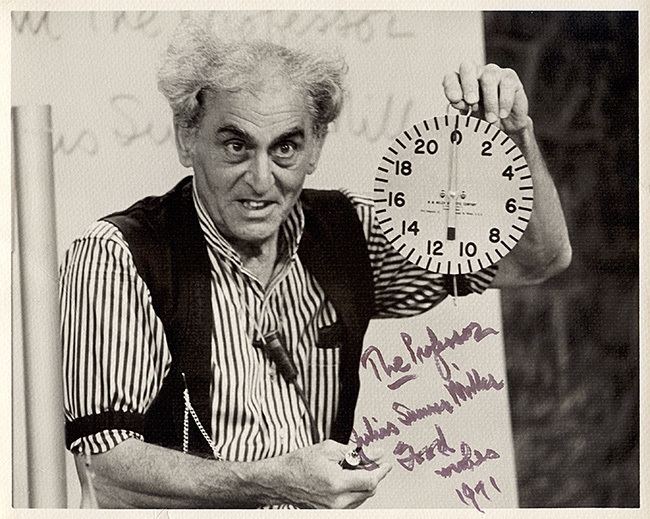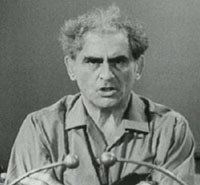Fields Physics education Role Physicist Name Julius Miller | ||
 | ||
Born May 17, 1909Billerica, Massachusetts ( 1909-05-17 ) Known for Children's television series Books Why is it So: Light and Modern Physics TV shows Demonstrations in Physics, The Hilarious House of Frightenstein, Science Demonstrations, The Mickey Mouse Club Similar People Billy Van, Walt Disney, Bill Walsh | ||
Julius sumner miller lesson 1 the idea of the center of gravity
Julius Sumner Miller (May 17, 1909 – April 14, 1987) was an American physicist and television personality. He is best known for his work on children's television programs in North America and Australia.
Contents
- Julius sumner miller lesson 1 the idea of the center of gravity
- Professor Millers pure joy as experiment takes unexpected turn 1964 RetroFocus
- Off screen
- Television
- Commercials
- Death
- Foundations
- Popular culture
- Albums
- References

Professor Miller's pure joy as experiment takes unexpected turn (1964) | RetroFocus
Off-screen

Julius Sumner Miller was born in Billerica, Massachusetts, as the youngest of nine children. His father was Latvian, his Lithuanian mother spoke 12 languages.
Miller graduated with a Master's degree and a PhD in physics from Boston University in 1933. Due to the Great Depression, he worked as a butler for a wealthy Boston doctor for the next two years. He married the doctor's maid, Alice Brown; they had no children, but he was to reach millions of children through his popular science programs.
After submitting over 700 job applications, he was offered a place in 1937 in the Physics Department of Dillard University, a private, African American liberal arts college in New Orleans. During World War II he worked as a civilian physicist for the US Army Signal Corps while holding fellowships in physics at the universities of Idaho and Oklahoma. He was a Ford Foundation Fellow at University of California, Los Angeles.
In 1950, he won a Carnegie Grant that allowed him to visit Albert Einstein at his home in Princeton, New Jersey, and also to visit the Institute for Advanced Studies. He greatly admired Einstein and went on to amass a collection of Einstein memorabilia that included Einstein's birth certificate. In 1952 Miller joined the Physics Department at the then small El Camino College in Torrance, California (1952–1974), to maximum student enrollments due to his great popularity and where he was instantly recognizable by his casual hair and horn-rimmed eyeglasses.
Miller was intolerant of misspelled words and misplaced punctuation, and often angered his colleagues because he charged that the students of most faculty were not learning enough. During an interview in the 1940s, he stated that intellectual life in America was in trouble, a belief he held for the rest of his life.
"We are approaching a darkness in the land. Boys and girls are emerging from every level of school with certificates and degrees, but they can't read, write or calculate. We don't have academic honesty or intellectual rigor. Schools have abandoned integrity and rigor."
From 1963 to 1986, he was the visiting lecturer for the Physics Department of the University of Sydney, and from 1965 to 1985 at the US Air Force Academy.
Television
In 1959, Miller began hosting his educational program, Why Is It So? on KNXT Channel 2 in Los Angeles. From 1962 to 1964, Miller was Disney's "Professor Wonderful" on new introductions, filmed at Disneyland, to the syndicated reruns of The Mickey Mouse Club. He also starred in the Disney series Great Moments in Science and Science and its Magic. During the same period, he appeared on a semi-regular basis performing physics experiments, on Steve Allen's late night TV show in Hollywood, syndicated by Group W. Eventually, he also had his own TV shows in Australia, Canada, Norway, and New Zealand.
Miller's first television appearance in Australia was on Bob Sanders People in 1963. In an improvised physics demonstration, he attempted to drive a drinking straw through a raw potato. A paper straw normally does not have sufficient strength but if one pinches the end, the trapped air acts as a piston, easily piercing the potato. For the first time in his career he could not get this to work, and he loudly exclaimed "Australian straws ain't worth a damn!". The next morning, Miller arrived at his Sydney University laboratory to find one million drinking straws on the floor with a telegram reading "You might find one of these fitting your requirements". He later stated "I sat amongst the straws with straws stuck in my hair and ears. But clearly I had made a mistake. I should have said: 'Australian potatoes ain’t worth a damn', and I’d have cornered the potato market!"
Shortly after, he was offered a job presenting science for Australia's ABC Television. When asked how much money he wanted, he replied that he never asked, he listened to an offer then "multiplied it by a factor between two and ten". Due to budget constraints the offer was withdrawn, but an agreement was reached for Miller to host his own science-based TV series which was filmed at the University of Sydney where he taught. Why Is It So? (the program title, which also would become his stock phrase), was broadcast from 1963 to 1986 and became an instant hit known for its "cool experiments, interesting science, and fantastic hair". The 1960s program became Demonstrations in Physics (also called Science Demonstrations when it was aired on American PBS television). He introduced each episode with the line: "How do you do, ladies and gentlemen, and boys and girls [sometimes adding "and teachers"]. I am Julius Sumner Miller, and physics is my business."
Around 1963, Miller was also one of the team of celebrity lecturers in the University of Sydney's pioneering "Summer School of Science", broadcast early in the morning during Australia's long summer holidays in January. Other fellow presenters included Professor Harry Messel, the astrophysicist, and the young James Watson, fresh from his triumphant co-discovery of the helical structure of DNA, but decades ahead of his work on the Human Genome.
"My first TV series on demonstrations in physics – titled Why Is It So? – were now seen and heard over the land. The mail was massive. The academics were a special triumph for me. They charged me with being superficial and trivial. If I had done what they wanted my programs would be as dull as their classes! I knew my purpose well and clear: to show how Nature behaves without cluttering its beauty with abstruse mathematics. Why cloud the charm of a Chladni plate with a Bessel function?"
Miller's on-air popularity was due to an enthusiasm not normally associated with serious science. Shows would be liberally sprinkled with phrases such as "He who is not stirred by the beauty of it is already dead!" and he also liked to trick the audience. A common ploy would be to hold up an empty glass and ask guests to confirm it was empty....then chide them for not noticing it was full of air. Before each demonstration he would usually ask for a show of hands to indicate which of several results they expected. Often he would then add "hands up those who don’t care".
In 1964 Miller suffered a near fatal heart attack. Scheduled to give a lecture in Australia, he sent Sydney University a telegram saying; "I've dropped dead here." He would suffer a second heart attack in 1986.
In 1966, questions from his show with an answer to the previous day’s question were published as "Millergrams" in The Australian newspaper. A selection of 112 of these questions was published as a book Millergrams; Some Enchanting Questions for Enquiring Minds. Further books were published in 1967: The Second Book of Millergrams: Some More Enchanting Questions for Enquiring Minds, and 1988: Why is it So?: The Very Best Millergrams of Professor Julius Sumner Miller.
Sample Millergram:
Q32: A juggler comes to a footbridge of rather flimsy design. He has in hand four balls. The maximum load is no more than the juggler himself and one ball. Can he get across the bridge by juggling the balls, always having at most one ball in the hand (and three in the air)?
A: No. A falling ball exerts a force on the hand greater than its own weight. Rather, a "thrown" ball exerts greater force than a "held" one. That is, the additional force equal and opposite to that imparted to a flung ball, in addition to the juggler's mass, would exceed the bridge's tolerance (the bridge can tolerate a juggler and held ball, but not the additional downward force associated with forcing a ball "up").
Miller appeared as "The Professor" in the Canadian series The Hilarious House of Frightenstein (1971), in a 4- to 5-minute segment each episode where he demonstrated physics experiments and explained the principles involved.
In the 1970s, Miller was also an occasional guest on The Tonight Show Starring Johnny Carson in the United States.
Commercials
During the 1980s, Miller appeared in a famous series of Australian television commercials for Cadbury chocolate, using his stock phrase "Why is it so?", demonstrating a simple scientific principle, and describing how each block of chocolate "embraces substantial nourishment and enjoyment," and contained "a glass and a half of full-cream dairy milk." The ads were sufficiently popular to be played for some years after his death.
While in Australia, Miller also appeared in ads for non-stick saucepans and Ampol petroleum, which included demonstrations of real principles of physics, albeit briefly.
Death
In February 1987, Miller became ill while visiting Australia and returned to the United States where he was diagnosed with leukemia. Miller died six weeks later on April 14, 1987, in Torrance, California. Miller willed his body to the University of Southern California's School of Dentistry; no services were held at his request.
Foundations
Professor Miller's wife, Alice Brown Miller, wanted to perpetuate the memory and achievements of her husband, and so conceived the idea of the Julius Sumner Miller Foundation, which was established in 1998.
Through an offer by Cadbury-Schweppes Pty Ltd, the Cadbury-Julius Sumner Miller Scholarship for Academic Excellence was set up to provide undergraduate scholarships in the School of Physics at the University of Sydney.
In 1993 the Australian Science Foundation for Physics established the Julius Sumner Miller Fellowship in his memory. The fellowship is currently held by Karl Kruszelnicki, best known as "Doctor Karl" for his appearances on Australian radio and television as a science commentator and author.
Popular culture
In 1966 Miller devised a word game, "Milleranagrams," which was published in Australia by John Sands Limited. The game, whose only materials were 200 Scrabble-like letter tiles, required players in their turn to draw an unseen tile from the "pool" then either make a word from their stock of tiles or add a tile to a word already on the table (rearrangement of the letters being permitted, hence the name) to form another word.
Miller remains popular in Australia, where he is still quoted. The phrase As Professor Julius Sumner Miller often asked, "Why is it so?" and its variations are still often used in newspaper articles that pose questions, even those unrelated to science.
